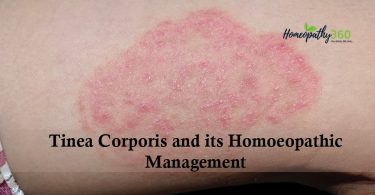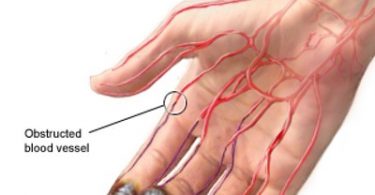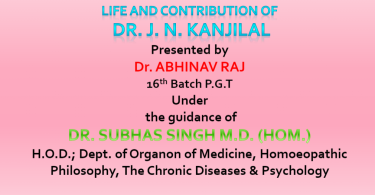Abstract: With the increase of the environmental pollution the prevalence of Allergic conjunctivitis is increasing day by day, which chiefly affects the children and younger age groups. Homoeopathic medicines are very safe and effective in the treatment of AC, as because with the alleviation of the signs and symptoms of AC, it also helps in minimizing the allergic tendency of the patient.
Introduction
Our conjunctiva is ten times more sensitive than the skin to allergens. Allergic conjunctivitis (AC) is the inflammation of conjunctiva due to allergic or hypersensitivity reactions which may be immediate (humoral) or delayed (cellular). Despite being the most benign form of conjunctivitis, AC has a considerable effect on patient quality of life, reduces work productivity, and increases health care costs. The modern medicine also has no permanent solution to this distressing trouble of eye which primarily affects the children and young adults except steroids and antihistaminics.
Prevalence
Most children with allergic conjunctivitis have allergic rhinitis. Older population studies estimate a prevalence of 15-20% of allergic conjunctivitis, but more recent studies implicate rates as high as 40%.
TYPES OF ALLERGIC CONJUNCTIVIS:
- Simple allergic conjunctivitis: It is a mild, non-specific AC characterised by itching, hyperaemia and mild papillary response.
- Vernal keratoconjunctivitis: It is a recurrent, bilateral, interstitial, self-limiting, allergic inflammation of the conjunctiva having a periodic seasonal incidence.
- Atopic keratoconjunctivitis: It can be thought of as an adult equivalent of vernal keratoconjunctivitis and is often associated with atopic dermatitis.
- Giant papillary conjunctivitis: It is the inflammation of conjunctiva with formation of very large sized papillae.
- Phlyctenular Keratoconjunctivitis: It is a characteristic nodular affection occurring as an allergic response of the conjunctival and corneal epithelium to some endogenous allergens to which they have become sensitized.
- Contact dermoconjunctivitis: It is an allergic disorder, involving conjunctiva and skin of lids along with surrounding area of face.
ETIOLOGY
- AC is caused by common allergens such as pollens, grass, animal dandruff, dust and mite.
- Giant papillary conjunctivitis is a localised allergic response to a physically rough or deposited surface (contact lens, prosthesis, left out nylon sutures).
- Phlyctenular keratoconjunctivitis is a delayed hypersensitivity response to endogenous microbial proteins. Causative allergens are Tuberculous proteins, Staphylococcus proteins, Moraxella Axenfeld bacillus and certain parasites.
PREDISPOSING FACTORS
- Age: Peak age group is 3-20 years.
- Sex: Vernal keratoconjunctivitis is more common in boys than girls. But the incidence is higher in girls than boys in Phlyctenular Keratoconjunctivitis.
- Undernourishment: Disease is more common in undernourished children.
- Living conditions: Overcrowded and unhygienic.
- Season: It occurs in all climates but incidence is high in spring and summer season.
- Climate: More prevalent in tropics.
PATHOLOGY
- Simple AC is characterised by sudden and extreme vasodilatation, followed by conjunctival infiltration and exudation, leading to swelling of conjunctiva followed increased capillary tissue formation and mild papillary hyperplasia.
- In Vernal keratoconjunctivitis conjunctival epithelium undergoes hyperplasia, adenoid layer shows marked cellular infiltration by eosinophils, plasma cells, lymphocytes, and histiocytes. Fibrous layer shows proliferation. Conjunctival vessel shows proliferation, increased permeability and vasodilatation. All these pathological changes lead to formation of multiple papillae in the upper tarsal conjunctiva.
- Pathology of Phlyctenular keratoconjunctivitis can be divided into 4 stages.
- Stage of nodule formation: Exudation and infiltration of leucocytes into deeper layers of conjunctiva leading to nodule formation.
- Stage of ulceration: Necrosis of apex of the nodules and ulcer formation.
- Stage of granulation: Eventually floor of ulcer gets covered with granulation tissue.
- Stage of healing: Healing occurs usually with minimal scarring.
CLINICAL PICTURE
SYMPTOMS
- SIMPLE ALLERGIC CONJUNCTIVITIS: Intense itching and burning sensation in the eyes associated with watery discharge and mild photophobia.
- VERNAL KERATOCONJUNCTIVITIS (SPRING CATARRH): Marked burning and itching, photophobia, lacrimation, stringy discharge and heaviness of lids.
- ATOPIC KERATOCONJUNCTIVITIS: Itching, soreness, dry sensation, mucoid discharge, photophobia or blurred vision.
- GIANT PAPILLARY CONJUNCTIVITIS: Itching, stringy discharge and reduced wearing time of contact lens.
- PHLYCTENULAR KERATOCONJUNCTIVITIS: Discomfort in the eye, irritation, and reflex watering. Associated mucopurulent conjunctivitis due to secondary bacterial infection.
- CONTACT DERMOCONJUNCTIVITIS: Weeping eczematous reaction, involving all areas with which medication comes in contact.
SIGNS
- SIMPLE ALLERGIC CONJUNCTIVITIS: Hyperaemia and chemosis of conjunctiva, mild papillary reaction of conjunctiva and oedema of lids.
- VERNAL KERATOCONJUNCTIVITIS: Characterised by presence of hard, flat topped papillae arranged in a cobble-stone fashion in upper tarsal conjunctiva. Gelatinous thickened accumulation of tissue around limbus, presence of Tranta’s spots along the limbus.
- ATOPIC KERATOCONJUNCTIVITIS: Lid margins chronically inflamed, tarsal conjunctiva show fine papillae, hyperaemia and scarring with shrinkage, cornea may show punctuate epithelial keratitis.
- GIANT PAPILLARY CONJUNCTIVITIS: Papillary hypertrophy of the upper tarsal conjunctiva.
- PHLYCTENULAR KERATOCONJUNCTIVITIS: Simple phlyctenular conjunctivitis is characterised by the presence of pinkish white nodule on bulbar conjunctiva near limbus.
- CONTACT DERMOCONJUNCTIVITIS: Hyperaemia with a generalised papillary response affecting the lower fornix and lower palpebral conjunctiva more than the upper.
DIAGNOSIS: is made from
- Typical symptoms and signs.
- Presence of abundant eosinophils in the discharge.
- Peripheral blood shows eosinophilia and increased serum IgE levels.
JUDGING GUIDELINES FOR 5-5-5 EXACERBATION GRADING SCALE FOR ALLERGIC CONJUNCTIVITIS DISEASE:
| Exacerbation grading scale | |||
| Grade of clinical sign | 100-point-grade | 10-point-grade | 1-point-grade |
| Clinical signs | · Active giant papillae † · Gelatinous infiltrates of the limbus · Exfoliative epithelial keratopathy · Shield Ulcer · Papillary proliferation at lower palpebral conjunctiva |
· Blepharitis · Papillary proliferation with velvety appearance · Horner-Trantas spots · Edema of bulbar conjunctiva · Superficial punctate keratopathy |
· Papillae at upper palpebral conjunctiva · Follicular lesion at lower palpebral conjunctiva · Hyperaemia of palpebral conjunctiva · Hyperaemia of bulbal conjunctiva · Lacrimal effusion |
| Score | 100 points × number of positive signs |
10 points × number of positive signs | 1 point × number of positive Signs |
| Range | 0-500 points | 0-50 points | 0-5 points |
MANAGEMENT
- General measures aimed to improve the health of child. Providing high protein diet supplemented with vitamins A, C and D.
- Dark goggles to prevent photophobia.
- Cold compresses and ice packs have soothing effects.
- Change of place from hot to cold area is recommended for recalcitrant cases.
HOMOEOPATHIC MANAGEMENT
There are many Homoeopathic medicines which can cure allergic conjunctivitis based upon the individualisation and miasmatic predominance of the patient. But here I am describing few among them with their indications according to the different stalwarts of our Homoeopathic system of medicine.
- ACONITUM NAPELLUS: Farrington says “Aconite is of service in conjunctivitis resulting from a foreign body in the eye. The eyes feel as if full of sand, and is exceedingly sensitive”. So we can think about Aconite in Giant papillary conjunctivitis.
- ANTIMONIUM CRUDUM: According to Samuel Lilienthal Ant crud is the drug for “Pustules on cornea or conjunctiva, especially in cross children; lids red, swollen, excoriated by profuse mucous discharge and lachrymation”.
- ARGENTUM NITRICUM: According to Farrington “Argentum nitricum is to be used after the failure of Pulsatilla”. As per Kent “All of the eye symptoms of Arg nit are worse in a warm room, worse from sitting by the fire. Wants cold applications, cold washing. Intense photophobia; aversion to light, wants it cold, wants it dark”.
- ARSENICUM ALBUM: Farrington says “Euphrasia is similar to Arsenicum album. Both have the acrid discharge and the formation of phlyctenulae on the cornea, and both indicated in scrofulous cases. But Arsenicum has more marked burning like fire, especially after midnight with restlessness”.
- BELLADONNA: Farrington states “In inflammation of the eyes, we find Belladonna indicated by the suddenness of the attack. There is great intolerance of light. The eye feels as if enormously swollen. The conjunctiva is bright red.”
- CALCAREA CARBONICA: Kent says “It is not especially suitable for every inflammation, but in those fat, flabby constitutions, where every cold settles in the eyes, and produces a inflammation. Photophobia is so marked that the Calcarea subject when he is at all disturb cannot even stand ordinary light, and to be out in the sunlight is extremely painful”.
- EUPHRASIA: Farrington mentions “In conjunctivitis, Euphrasia is sometimes indicated in scrofulous cases. Little blisters or phlyctenulae form on or near the cornea; the discharges from the eyes are acrid and purulent and a film of mucus seems to collect over the cornea, causing a difficulty in vision. This blurred sight is relieved by wiping the eye or by winking”.
- MERCURIUS: According to Kent “Mercurius is a wonderful eye remedy, especially for colds. There is copious lachrymation with all eye symptoms, and the tears excoriate, causing a red line down the cheeks. Catarrh of the eyes worse from looking into the fire or rather from sitting close to the fire; the radiated heat causes smarting”.
- PULSATILLA: According to Farrington “Pulsatilla is not indicated in the beginning of the disease, but later in its course, when the symptoms have matured. Pustules on the cornea, with very little dread of light, but with lachrymation, worse in the open air”.
- SEPIA: According to Farrington “In conjunctivitis you will find Sepia indicated when the inflammation is of a sluggish type, occurring generally in scrofulous children. The symptoms are subacute. There is muco-purulent discharge in the morning. The eyes feel comparatively comfortable during the day, while in the evening there is an annoying dryness of the conjunctiva”.
- SULPHUR: Farrington states “Sulphur is indicated in conjunctivitis from irritation of foreign bodies when Aconite fails”. As per Kent Sulphur is useful for “Catarrhal eye symptoms that are made worpse from washing. Eye symptoms with eruptions on the face and scalp, with itching of the skin, especially when warm in bed”.
- SYPHILINUM: According to Samuel Lilienthal Syphilinum have great value in “Chronic recurrent phlyctenular inflammation of conjunctiva and cornea; intense photophobia; profuse lacrimation, especially in delicate scrofulous children with a hereditary syphilitic taint”.
COMMENT
As I have already mentioned AC primarily affects the children and teenagers [the future of the nation] rendering their everyday life miserable as well as hampers their academic activity. We Homoeopaths can help out these suffering children with our dynamic medicine as evident from our literatures in the shortest, most reliable, and most harmless way. But we should also conduct some meaningful systemic research to prove the efficacy of Homoeopathic dynamic medicines in disease conditions like AC to establish the superiority of Homoeopathic system of medicine above all.
REFERENCES:
- Farrington E A. Lectures on Clinical Materia Medica in Family Order. New Delhi: B Jain Publishers (P) LTD; 2014.
- Kent J T. Lectures on Homoeopathic Materia Medica. New Delhi: B Jain Publishers (P) LTD; 2011.
- Khurana A K. Comprehensive Ophthalmology. 4th New Delhi: New Age International (P) Limited Publishers; 2010.
- Lilienthal S. Homoeopathic Therapeutics. New Delhi: B Jain Publishers (P) LTD; 2016.
- Rosario N, Bielory L. Epidemiology of Allergic Conjunctivitis. Curr Opin Allergy Clin Immunol. 2011 Oct 11 (5): 471-476. DOI: 10.1097/ACI. 0b013e32834a9676 [cited 2017 Jan 5]. Available from: http://www.ncbi.nlm.nih.gov/pubmed/21785348.
- Shoji J, Inada N, Sawa M. Evaluation of Novel Scoring System Named 5-5-5 Exacerbation Grading Scale for Allergic Conjunctivitis Disease. Allergology International. 2009; 58 (4); 591-597. DOI: 10.2332/allergolint. 09-OA-0100.





